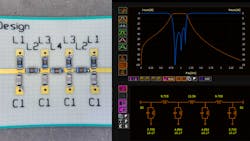Accurate Models and Discrete Part-Value Optimization Combine to Improve Workflows (.PDF Download)
Designing RF filters and other high-frequency circuits with today’s simulation software tools often involves performing some form of optimization to achieve the desired performance. For example, take the case of a lumped-element filter. Optimizing such a filter involves adjusting the values of its lumped components until the filter achieves an optimal frequency response.
However, once the component values have been determined via optimization, they may still need to be adjusted to the closest discrete, or “real-life,” manufacturer part values. Depending on the design’s complexity, this extra step can create a bit of extra legwork for the designer.
